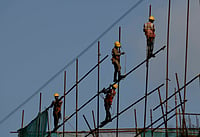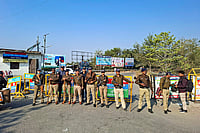
Millions in India need mental health care, but most don’t get it due to stigma and lack of services.
Government programmes exist, but deep-rooted beliefs and low funding limit their impact.
Personal stories reveal loneliness, neglect, and a system that still treats mental health as an afterthought.
Despite growing awareness of mental health conditions, a troubling paradox endures. Even as the world prepares to mark World Mental Health Day on 10 October, the silence and stigma continue to shadow those who struggle in private.
Access to Services: Mental Health in Catastrophes and Emergencies, which is the theme for 2025 serves as a stark reminder of the urgent need for inclusive and resilient mental health systems, especially in times of crisis.
Reflecting on our national progress, we must ask: Where does mental health truly stand in our priorities, both as a nation and as individuals? According to the National Mental Health Survey conducted by NIMHANS in 2016, nearly 150 million people in India are in need of mental health services. Shockingly, only 10 to 15 percent receive adequate care.
This issue is further compounded by the dearth of mental health professionals in the country. Social stigma and limited access to support make it even more difficult for those in need to seek help. According to the Ministry of Health and Family Welfare, approximately 70 to 92 percent of people with mental disorders do not receive proper treatment due to a lack of awareness, prevailing taboos, and an insufficient number of qualified professionals.
Both infrastructure and incentives remain largely absent from this sector. A telling figure lies in the fact that the country's expenditure on mental health is one percent of the health budget, which itself is a measly two percent of the GDP. This allocation is proportionately lower than that of Ethiopia, Sudan, Ghana, Afghanistan, Bhutan, Botswana, and Congo, all of which are poorer than India.
In Outlook magazine’s special Independence Day issue on mental health, Everyday I Pray For Love, we looked at if we can imagine a nation where freedom includes freedom from the stigma of mental illness.
Outlook editor Chinki Sinha wrote how many people have asked her why she decided to curate an issue on mental health. “I think the answer lies in the memory. An old, painful one, but I wanted to be free to confront it on the page and to write a letter to my dead grandfather, who once was a caregiver to his youngest son, who suffered from schizophrenia. My uncle was a brilliant doctor and a gentle person. He wasn’t perfect, but he was family.”
Vandana Gopikumar narrated the tale of Kali, A Personal Story Of Mental Health, Healing, And The Complexity Of Care. Both Vandana and her colleague Vaishnavi Jayakumar were 24. Kali must have been in her 40s, though she looked much older. It seemed like she had starved for many days, months even, finding the most obscure yet ingenious ways to get something into her body to survive.
All Vandana did was sit with her and cajole her to eat and meet her where she wanted to be met; no jargon, no technique, just plain common sense—wisdom drawn from suffering and emanating from a shared feeling of alienation, perhaps? She grew weaker and, in her frailty, surrendered her faith and hope. “We carried her to the hospital. And cared for her until she died. We were novices then, and it tore us apart as it still does now.”
The support that Kali received is oblivious to most. World Health Organisation data highlights that in India, the age-adjusted suicide rate per 100000 population is 21.1. Even if the issue is diagnosed or identified, the modus operandi still remains primitive.
Swati Subhedar highlighted how in Uttar Pradesh, India’s most populous state, genuine efforts are being made under the District Mental Health Programme to help people with mental illnesses. However, a large section of disadvantaged society is still slipping through the cracks.
After the Mental Healthcare Act came into effect on July 7, 2018, many initiatives were launched across UP under the DMHP. The Dawa Se Dua Tak programme was among those. A large section of society still takes family members with mental illness to a religious place where an ojha (traditional healer) or the like “cures” the patients by performing jhaad phoonk. The aim of the initiative was to counsel and encourage such families to seek medical help.
In the World Mental Health Day issue of Outlook Magazine, titled I Have a Lot Left Inside (October 11, 2025), Part 2, we delved into the challenges faced by those living with mental health struggles, as well as the experiences of those who dedicate their lives to offering care and support.
In 'Why Awareness Of Mental Health Disorders Will Never Be Enough Without Improved Care Services’, Anirudh Kala wrote, ‘By the end of the said Mental Health Day, there would have been seminars, talk shows, discussions and debates.’ It would also have been pointed out that nearly 200,000 Indians die by suicide every year, according to WHO figures, and that each suicide inherently is an avoidable death. And that for every completed suicide there are ten attempted suicides.
That the country’s suicide data is compiled by the National Crime Records Bureau is, in itself, a telling indictment of our attitude towards the immense tragedy of suicide.
When Kala was training to be a psychiatrist, decades back at PGI Chandigarh, he was told that India had just 300 psychiatrists and once that number reached 3,000, all its mental health problems would be solved. Today India has about 10,000 psychiatrists and it still seems far from enough.
Several such cases suffer from and are aggravated by loneliness, ‘There is nobody to talk to’ is why, if you ask them.
In ‘Languishing in Loneliness’, Snigdhendhu Bhattacharya narrates the story of Anjan Chatterjee fixing an appointment with a mental health professional the day after he screamed at Siri and threw his whiskey-filled glass at the speaker.
“The lack of real conversations is a horrible thing,” says the 36-year-old photographer working in the entertainment industry. “But what do you do when you have no human connection without transactional relations?”
If this is the regular condition, the detrimental state of Indian prisons with respect to mental health is even more concerning. In ‘Lives Fading in Silence Behind Iron Walls,’ Sudhir Dhawale cites the example of Taloja Central Jail in Maharashtra. There is only one psychiatrist in the Taloja Central Jail, and even she does not work full time. At present, the psychotherapists serving in the prison aren’t even adequately trained.
Other medical issues, at least, receive medications, but that is not available for mental health issues. Only sleeping pills are handed out for such problems!
In ‘An Imprisoned Mind’, Apeksha Priyadarshini highlights the case of G.N. Saibaba—an assistant professor of English at Ram Lal Anand College, Delhi University, who was arrested near his home in Delhi on May 14, 2014, on charges of alleged Maoist links, He had been released after more than eight and a half years in prison with 19 new ailments. His death on October 12, 2024, has been attributed to the severe medical negligence that he faced during his prolonged incarceration.
Beyond the speeches, seminars, and symbolic observances, lies a simple truth: mental health care in India is still treated as an afterthought, not an essential right. Until empathy shapes policy and care becomes accessible to all, whether in villages or cities or prisons, the silence will persist.









.png?auto=format%2Ccompress&fit=max&format=webp&w=768&dpr=1.0)

















